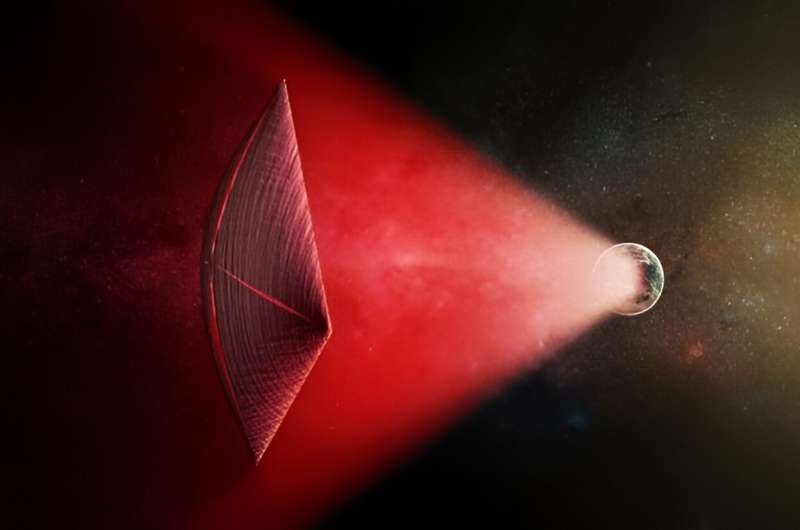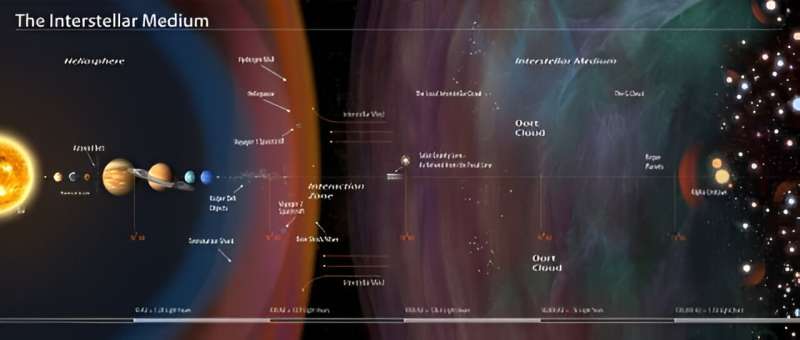This article has been reviewed according to Science X's editorial process and policies. Editors have highlighted the following attributes while ensuring the content's credibility:
fact-checked
preprint
trusted source
proofread
Communicating with a relativistic spacecraft gets pretty weird

Someday, in the not-too-distant future, humans may send robotic probes to explore nearby star systems. These robot explorers will likely take the form of lightsails and wafercraft (a la Breakthrough Starshot) that will rely on directed energy (lasers) to accelerate to relativistic speeds—aka a fraction of the speed of light. With that kind of velocity, lightsails and wafercraft could make the journey across interstellar space in a matter of decades instead of centuries (or longer!) Given time, these missions could serve as pathfinders for more ambitious exploration programs involving astronauts.
Of course, any talk of interstellar travel must consider the massive technical challenges this entails. In a recent paper posted to the arXiv preprint server, a team of engineers and astrophysicists considered the effects that relativistic space travel will have on communications. Their results showed that during the cruise phase of the mission (where a spacecraft is traveling close to the speed of light), communications become problematic for one-way and two-way transmissions. This will pose significant challenges for crewed missions but will leave robotic missions largely unaffected.
The team consisted of David Messerschmitt, a Professor Emeritus of Electrical Engineering and Computer Science at the University of California at Berkeley; Ian Morrison, a Research Fellow at Curtin University's International Center for Radio Astronomy Research (ICRAR) and the communications and signal processing developer Astro Signal Pty Ltd; Thomas Mozdzen, a research scientist in the School of Earth and Space Exploration at Arizona State University; and Philip Lubin, a professor of physics and the head of the Experimental Cosmology Group at UC Santa Barbara. The preprint of their paper recently appeared online and is being reviewed for publication by Elsevier.
For their study, the team considered both robotic (uncrewed) and crewed mission profiles. The former consists of concepts similar to the Starshot and Directed Energy Propulsion for Interstellar Exploration (DEEP-In)—aka. Starlight—concepts. This latter concept is one that Prof. Lubin and his colleagues at UCSB Experimental Cosmology Group have been developing since 2014 through the NASA Innovative Advanced Concepts (NIAC) program. However, their analysis differed since it considers scenarios where spacecraft are approaching the speed of light—rather than the 10% to 20% called for with the Starlight and Starshot concepts.
For uncrewed missions, remote control operations and data transmission require reliable communications during certain phases. For crewed missions, however, maintaining persistent communications with home is crucial to the long-term well-being of astronauts. Regardless of the mission profile, communications invariably come down to transmissions in the electromagnetic spectrum (radio waves, lasers, etc.) and how they propagate through space. As the team told Universe Today via email:
"The assumption we're making is that communication signals are electromagnetic, hence conveyed via photons. This relates to the propagation speed of a communication signal, which relates to the propagation delay. The timing/latency relationships are independent of the wavelength and hence apply equally to radio, microwave, or optical."

Another key consideration is that communications at relativistic speeds must take into account the effects of Special Relativity. In short, a spacecraft traveling at a significant fraction of the speed of light will experience time dilation, where its internal clocks will advance more slowly than mission clocks on Earth. Another consideration is that communications to and from the mission will be subject to Doppler Shift. As Special Relativity teaches us, the speed of light is constant in a vacuum and does not speed up or slow down based on the motion of the observer or source.
But if the space between objects is expanding, the wavelength of the light will be shifted towards the red end of the spectrum (aka redshift). Their analysis found that the situation would be simpler for robotic missions, as communications are only required during the landing phase. However, for crewed missions, persistent communication is desirable for all phases of the mission, including the cruise phase (when the spacecraft will be accelerated to relativistic speed). In this case, said the team, problems emerged:
"The main effects considered are large propagation delays together with the time dilation of clocks traveling at high speed. The analysis is from the point of view of a traveler at relativistic speed rather than an inertial observer (like in an astronomy observatory), which to our knowledge, has not been considered previously in the literature. The results show that round-trip message latencies can be extremely high, rates of streaming media can be significantly slowed, and under certain circumstances, communications become impossible. Relativistic spacecraft and their astronauts must function largely autonomously."
These results have serious implications for the feasibility of interstellar missions. The inability to maintain contact with Earth at certain periods in the mission, the difficulty of transmitting information, and the need for autonomy all present significant challenges. Under these circumstances, future generations may choose to restrict interstellar missions to robotic explorers. Alternatively, they may choose to place crews in hibernation or cryogenic suspension so no communication is needed during the cruise phase.
However, as the team noted, their analysis comes down to quantifying the challenges of maintaining communications with a relativistic mission. This is absolutely necessary before any attempts can be made to plan for interstellar exploration. In addition, there are likely to be several innovations and changes between now and the day that human interstellar missions are being contemplated that could alter the picture. As they summarized:
"[T]he design of any future interstellar missions involving astronauts, especially at greater distances, will be significantly affected by the limits to communications imposed by large distances and spacecraft speeds near the speed of light. While the analytical approach is general, the numerical results are applied to hypothetical future missions where humans travel at close to the speed of light. While such speeds are not feasible with current propulsion technologies, this may change. These speeds may not be necessary for human travel to the nearest stars, but would enable travel to much greater distances within a typical human lifetime."
More information: David Messerschmitt et al, Timing relationships and resulting communications challenges in relativistic travel, arXiv (2023). DOI: 10.48550/arxiv.2311.14039
Journal information: arXiv
Provided by Universe Today





















